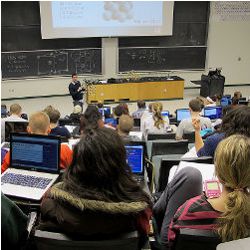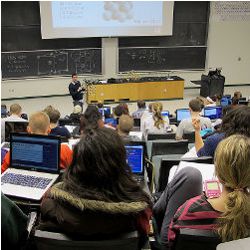
When you cheat, you only cheat yourself,” is an oft-repeated pearl of wisdom from teachers, parents, and enlightened students alike. Nevertheless, 65–75% percent of college-age students have admitted to cheating at one time or another, according to surveys conducted in the early 1960s, and recent studies indicate cheating still remains rampant. Indeed, Harvard University forced out 70 students for cheating during a May 2012 final exam, and in 2015, more than 60 Dartmouth College students were accused of cheating in a sports-ethics class.
In response to such incidents, as well as growing pressure from accreditation bodies, employers, and even alumni, traditional campus-based institutions and online universities are implementing technological solutions for stopping cheaters.
Institutions also are being closely monitored by the U.S. Department of Education, which oversees the financial aid/student loan eligibility process through which most schools receive the majority of their funding. “The Department of Education took a stronger stance when the Office of Inspector General did its audits for financial aid disbursements,” according to Tim Dutta, CEO of Verificient Technologies, a provider of student verification and anti-cheating technology. “From that perspective, schools have taken a more proactive and rigorous approach” to ensuring academic integrity with their programs. “Now these [verification and integrity solutions] have kind of gotten on the radar of institutions as a ‘need to have,’ rather than a ‘nice to have.’ “
The challenge faced by these institutions is twofold: schools must ensure the work a student turns in throughout the duration of the course is his or her own work, as well as preventing or discouraging students from cheating on examinations. Ultimately, if cheating is seen as pervasive, the reputation of the school, as well as its graduates and faculty, will suffer.
One Step Ahead
While students from earlier eras plagiarized authors’ works and liberally quoted from other students’ previous papers, it required nearly as much time and effort to retype the work as it would to simply complete the assignment properly. The advent of computer- and Internet-based learning made it easier to copy-and-paste from ever-growing annals of legitimate source material. Furthermore, websites have sprung up to offer custom-written papers on hundreds of subjects, presumably properly sourced and annotated to pass muster with most professors.
The ease and pervasiveness of plagiarism is driving the use of technology to assess the originality of student-submitted work. Scanning software such as Turnitin (http://turnitin.com/), which The New York Times reported being used by more than 3,500 universities, compares student-submitted work with content on the Web, as well as student-submitted papers. According to the company Turnitin, the software uses a matching algorithm to identify passages of words within submitted work identical to those found within its repository of content. The result is an “originality report,” indicating the degree of similarity between submitted work and sources of content contained in the database. As such, human judgment is also required to determine if an instance of plagiarism has occurred.
Software, however, cannot catch all instances of students passing off the work of others as their own, particularly as online courses continue to grow in popularity among both traditional educational institutions and for-profit providers. For providers that offer fully online courses, it has become increasingly important to verify a student’s work is that of the person who originally registered for the course and will be receiving a credential for completing it successfully.
Testing the Limits
Most course providers that offer a certification or fully accredited degree use examinations to demonstrate proficiency with a subject area. Not surprisingly, many students try to game the system and cheat on these exams, generally motivated by achieving an external reward such as a good grade in a course, the satisfaction of a degree program and, eventually, the securing of a good (or better) job.
Students have migrated from old-school cheating techniques (such as writing answers on their clothing) to more technologically advanced methods that are specifically designed to avoid detection by proctors. For example, students have scanned a beverage label into an image-editing program, replaced the small text listing the ingredients with exam answers, and reprinted and pasted the label back onto the bottle to serve as a cheating aid that is hiding in plain sight, usually undetected by proctors. Other students have used electronic devices to facilitate cheating, such as by loading cheat sheets into cellphones, calculators, watches, or other devices, or using them to share information surreptitiously.
To combat these types of schemes, traditional universities have embraced an approach that mirrors a ‘clean room’—a highly monitored, controlled environment that makes cheating very difficult. The campus-based University of Central Florida is one of many schools that use an ultra-secure testing facility to thwart cheaters; students entering the center must lock up all personal property, with the exception of identification documents. The room is under surveillance by video cameras and live proctors, there are no scheduled breaks, and two forms of ID are required to verify the test taker’s identity.
Online Verification
In an online test-taking environment, it is much harder to verify students are not cheating, simply because it is not possible to truly know if something or someone else is assisting them during the exam.
There are a number of software-based solutions designed to make it more difficult for online students to cheat. These systems are not foolproof and will not stop a truly determined person cheating, but may deter casual cheaters, and demonstrate a school’s commitment to reducing academic fraud.
Software Secure’s RPNow or Verificient Technologies’ ProctorTrack each use a combination of software, analytics engines, and vision- and sensor-based systems to verify students are who they say they are, are engaged in coursework, and are closely monitored to prevent cheating.
At massive open online course (MOOC) provider edX, vice president of product Beth Porter says, “Our vendor is Software Secure, and what it does is look for anomalies.”
Software Secure’s RPNow captures images of student test takers and their respective photo IDs. The test takers must confirm the images can be later used to authenticate their identity by matching the photo when the test-taker logs in to take the test. The system also supports application blacklisting to prevent the test-taker from using unauthorized programs on their computer before or during a test, and records the entire exam session using their webcam and microphone. This video is stored, along with everything that is displayed on the user’s screen, to allow quick review of the test and the environment by certified proctors, who can review any anomalies that may be indicative of someone trying to cheat, such as frequently looking away from the screen to read a nearby book, cheatsheet, or second computer screen out of view of the webcam.
Software-based systems will not stop a truly determined character, but demonstrate a school’s commitment to reducing academic fraud.
Verificient Technology’s ProctorTrack operates in a similar fashion, tracking eye movement to determine if the subject is looking away from the screen (to prevent stealing glances at a cheat sheet), while the microphone records audio to detect extraneous noise that could be indicative of someone else in the room assisting the test-taker.
Verificient’s Dutta contends monitoring test-takers is not about forcing students to be “robots” during an exam, but simply ensuring they can be “seen” by the verification software, and creating a record that can be reviewed to see if behavior that could be construed as cheating is present.
Some observers have raised concerns about student privacy with anti-cheating software that records facial and other personal identification details, which are sent back over the Internet. For its part, Verificient claims Proctortrack complies with the U.S. Family Educational Rights and Privacy Act (FERPA), and has pledged that the software does not access any files on a student’s hard drive, does not share any data with third parties, and purges personal student data within 30-60 days, depending upon the university.
Unlike K–12 students, college attendees ultimately have the choice of whether or not to attend a school that uses this type of technology. Moreover, students seeking an online degree that is well respected and valued in the marketplace likely will seek out schools that are taking steps to improve their reputations, even if it means subjecting themselves to remote monitoring.
The key, according to security and technology expert Joseph Kirkpatrick of Kirkpatrick Price, a Tampa, FL-based licensed CPA and PCI quality security assessor firm, is for both the vendors supplying the monitoring software and the schools utilizing it to have clear privacy and security policies, as well as having a compliance officer or team to ensure these policies are enforced.
Kirkpatrick expects the debate over the fair, ethical use of monitoring and verification of student activities for online and traditional universities will continue, likely as part of the overarching debate over data collection, privacy, and protection by private companies and the government. “There are all these ethical questions,” Kirkpatrick says. However, he notes that to enjoy certain conveniences, such as attending classes and taking exams online, “you’re going to give up some privacy.”
Still, stopping or reducing cheating is not the only area in which online educational providers must consider how they interact with students. A recent settlement between edX and the U.S. Department of Justice under which the MOOC provider will make its website and course delivery platform accessible to blind and hard-of-hearing students and to those with other physical disabilities, has thrown a light on the need for online education providers to comply with the Americans With Disabilities Act (ADA). This is especially important for any institution that receives federal funds (via grants or student loans), as Section 504 of the ADA specifies no qualified individual will be excluded from a program or activity that receives federal funding.
Similarly, educational institutions are likely to want to comply with Section 508 of the ADA, which requires electronic and information technology to be accessible to people with disabilities, to attract the maximum number of potential students and avoid any potential legislation related to discrimination.
Overall, the benefits of online education providers deploying anti-cheating, verification, and accessibility software far outweigh the costs, particularly with respect to the growing population of non-traditional students flocking to online degree programs.
Dan Butin, founding dean of the School of Education & Social Policy at Merrimack College, notes that implementing these systems is fairly easy for schools to do, even if there is some pushback from students. Indeed, students must agree to the terms and conditions of using the school’s software-based online learning platform in order to take courses, and as such, likely will agree to use this type of exam monitoring as a condition of receiving course credentials.
It is key that vendors supplying monitoring software and schools utilizing it have clear privacy and security policies, along with a compliance officer or team to ensure policies are enforced.
“The economics of this [online] model are going to necessitate that,” Butin says. “The front-end investment that [Arizona State University] or anyone else is going to have to put in for student verification or anti-cheating technology is minimal, compared with the potential for revenue generation that will happen once they figure out these questions,” Butin says.
For its part, edX says there will be no changes in course pricing due to the company’s accessibility efforts. “Any investment by edX or course content providers with regard to accessibility is not passed on to the students,” says edX general counsel Tena Herlihy.
Further Reading
Harvard Cheating Scandal: http://www.thecrimson.com/article/2012/8/30/academic-dishonesty-ad-board/
Cheating Survey: https://www.insidehighered.com/news/2012/03/16/arizona-survey-examines-student-cheating-faculty-responses
University of Central Florida Testing Center Video-How it Works: http://utc.sdes.ucf.edu/





Join the Discussion (0)
Become a Member or Sign In to Post a Comment